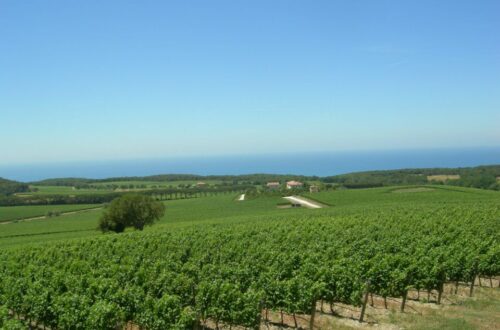Table of Contents
What is Langhe DOC? Piedmont’s Most Versatile Wine Appellation
Langhe DOC represents the beating heart of Piedmont’s wine culture. Established in 1994, this appellation spans the hills surrounding Barolo, Barbaresco, and Roero—offering a remarkable variety of styles from elegant Arneis whites to structured Nebbiolo reds. The name “Langhe” derives from the local dialect meaning “long hills,” and it’s within these undulating UNESCO-listed landscapes that the wines express both history and innovation.
History and Origins
Though officially recognized less than three decades ago, Langhe DOC is built on centuries of viticulture. These lands were cultivated by Roman settlers, nurtured by medieval monasteries, and refined by noble families. The modern DOC was designed to give winemakers creative freedom while maintaining high standards—allowing them to bottle wines from local varieties without the stricter regulations of Barolo or Barbaresco.
Where It’s Made: Geography & Terroir
The Langhe lies in Cuneo province, in southern Piedmont, stretching across steep slopes, river valleys, and panoramic ridges. The UNESCO designation celebrates its “cultural landscape of outstanding universal value,” where vineyards, castles, and medieval towns intertwine. Soils range from calcareous marl to sandy clay, creating diverse micro-terroirs. Altitudes vary from 150 to 600 meters, with a continental climate moderated by the Tanaro River.
The Grapes
The Langhe DOC permits a wide array of varieties:
- Nebbiolo: The noble grape of Barolo and Barbaresco, producing wines with structure, rose-scented aromatics, and aging potential.
- Barbera: Juicy and approachable, with vibrant acidity and red fruit character.
- Dolcetto: Soft tannins and dark fruit, ideal for everyday drinking.
- Arneis: Piedmont’s flagship white, crisp with pear and almond notes.
- International varieties: Chardonnay, Sauvignon Blanc, and Merlot appear in creative blends.
Winemaking & DOC Regulations
Langhe DOC is intentionally flexible—allowing single-variety or blended wines. Reds require a minimum of 85% of the named grape, whites 100% of the named grape. Nebbiolo-based Langhe wines must age at least 12 months before release. This versatility empowers producers to experiment, while still guaranteeing geographic authenticity.
Key Facts at a Glance
- Established: 1994
- Region: Piedmont, Italy
- UNESCO World Heritage: Yes (since 2014)
- Styles: Red, White, Rosato, Passito
- Key Grapes: Nebbiolo, Barbera, Dolcetto, Arneis
- Aging Requirements: Varies by grape/style
Tasting Notes
Langhe DOC wines reflect the diversity of their terroir:
- Nebbiolo: Rose petals, cherries, tar, fine tannins.
- Barbera: Black cherry, plum, refreshing acidity.
- Dolcetto: Blackberry, licorice, gentle tannins.
- Arneis: White peach, pear, almond, mineral finish.
Serving & Pairing
Langhe reds pair beautifully with Piedmont’s rich cuisine—tajarin pasta with ragù, brasato al Barolo, or aged cheeses. Arneis complements hazelnut salads, vitello tonnato, or seafood antipasti. Serve reds at 16–18°C and whites at 8–10°C.
Where to Buy & Pricing
Langhe DOC offers exceptional value:
- Nebbiolo: €15–€30 for top producers.
- Arneis: €10–€20.
- Widely available via Italian wine specialists, reputable online retailers, and local enotecas in Alba.
Langhe vs Barolo vs Barbaresco: What’s the Difference?
| Feature | Langhe DOC | Barolo DOCG | Barbaresco DOCG |
| Main Grape | Multiple | Nebbiolo (100%) | Nebbiolo (100%) |
| Aging Requirement | Flexible | Min. 38 months | Min. 26 months |
| Price Range | €10–€30 | €40–€200+ | €30–€150+ |
| Style Range | Very broad | Structured, long-lived | Elegant, aromatic |
| Accessibility | High | Collectors | Enthusiasts |
FAQ on Langhe DOC
Q: Is Langhe DOC a good introduction to Piedmont wines?
Yes—its affordability and variety make it ideal for newcomers.
Q: Can Langhe DOC wines age?
Nebbiolo-based versions can develop for 5–10 years, sometimes longer.
Q: Why is Langhe a UNESCO site?
For its unique vineyard landscapes shaped by centuries of human tradition.
Fun Facts & Cultural Notes
- The Langhe is home to Alba’s white truffle festival, where local wines star alongside the prized fungi.
- The rolling vineyard landscapes inspired the works of writer Cesare Pavese.
- The name “Langhe” is always plural—reflecting the many hills and villages that shape its identity.
CTA for Audience Engagement
“Which Langhe DOC wine would you try first—crisp Arneis or bold Nebbiolo? Share your choice in the comments, and explore our Piedmont wine guide for more travel and tasting inspiration.”


